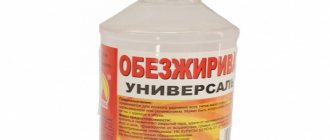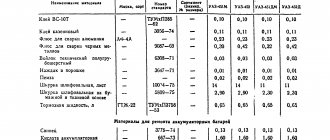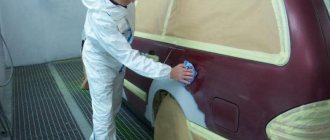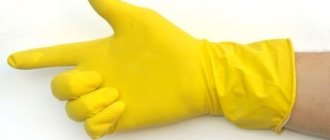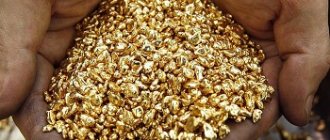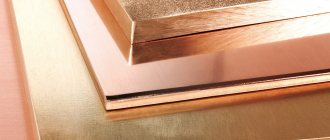For high-quality application of galvanic, paint and varnish (including powder) and other types of coatings, it is necessary to carry out thorough preliminary preparation of the metal surface. The most important stage in preparing a surface for coating is removing various contaminants from the surface (degreasing the metal surface). The choice of the type of metal degreasing and the composition of the solution depends on the type of coating applied, the metal and the condition of its surface, and the conditions available at the enterprise (including equipment and treatment facilities).
When applying galvanic coatings to steel parts, chemical and electrochemical degreasing of the surface must be carried out.
When applying oxide and phosphate coatings to steel, when coating aluminum, copper and zinc alloys, when applying paint and varnish and powder coatings, usually only chemical degreasing of the surface is carried out. In some cases, when the parts being processed are not very greasy, chemical degreasing of the parts is combined with etching (ECOMET-A006 process). When carrying out only chemical degreasing of metal, it is recommended to install 2 baths in succession (of the same composition or different, for example, degreasing and degreasing-etching).
We do not recommend using one bath for degreasing various metals (steel, aluminum, copper alloys, etc.), as this always reduces the quality of the resulting coatings.
To select degreasing compounds, use their comparative characteristics presented in the tables.
Cleaning and degreasing surfaces to be bonded
The purpose of this operation is to remove various contaminants from the bonded surfaces that cause a decrease in the strength of the adhesive joints. The level of strength reduction depends on the nature of the substance contaminating the surface, its concentration on the surface, as well as on the composition of the bonded material and the adhesive used.
The maximum permissible concentration of contaminants that does not affect adhesion is from 0.01 to 1 mg per 1.5 cm2 of surface area.
To degrease surfaces to be bonded, organic solvents, aqueous detergents, alkaline preparations and special alkaline compounds are used.
Gasoline and acetone are usually used as solvents for degreasing metal surfaces; for degreasing surfaces of polymeric materials and rubber - tetrachlorethylene, trichlorethylene and isopropyl alcohol, provided that these materials do not dissolve in the selected solvent.
When using solvents by wiping the surface, only incomplete cleaning can be achieved, since contaminants only move along the treated surface.
Organic solvents cannot be used:
1) to remove contaminants containing soap, grinding paste, dust, etc., since they only dissolve fat, and inorganic residues are not completely removed from the metal surface;
2) for degreasing wet surfaces, since they do not mix with water and in wet areas do not penetrate the metal surface.
Degreasing with organic solvents
The surfaces of most plastics absorb solvents, therefore, after degreasing the surface, sufficient open exposure should be allowed until the solvent is completely removed or accelerated drying is carried out, otherwise the formation of a porous adhesive joint may occur.
Organic solvents are highly flammable. In order to reduce the fire hazard, antistatic additives are introduced into their composition, for example Sigbol (TU 38.101741-78), which is added to the solvent in an amount of 0.002% (wt).
It is preferable to degrease metal surfaces (with the exception of titanium alloys) in solvent vapors, such as trichlorethylene or tetrachlorethylene. Due to the temperature difference between the solvent vapor and the metal, the solvent vapor condenses on the metal parts, dissolving contaminants. Many vapor degreasing units are equipped with a device for spraying parts with clean solvent. Trichlorethylene vapors degrease steel, tungsten, magnesium and molybdenum alloys; tetrachlorethylene vapors degrease aluminum, aluminum, tungsten, magnesium and molybdenum alloys. Treatment duration is 0.5-5 minutes.
Degreasing with detergents
Aqueous detergents can be used to degrease metal surfaces. A very effective washing solution is TMS-31 (TU 38.40740-71), which is an aqueous solution of a mixture of surfactants, monoethanolamides, oleic acid, ethyl alcohol and triethanolamine (trihydroxyethylamine).
As a washing solution, you can also use a composition containing sodium phosphate (16 g/l) and the emulsifier Syntamid-5 (2 g/l), which can be disposed of by biological decomposition.
Degreasing with aqueous solutions of detergents is carried out using the following technology: washing by dipping into an aqueous solution of detergent at a temperature of 70-80 0C for 3-15 minutes; sequential rinsing in hot (60-70 0C) and cold (15-20 0C) running water. To prevent corrosion, metal surfaces, after washing in water, are treated with a cold aqueous 0.5% solution of potassium dichromate and dried at a temperature of 110-120 0C. This surface treatment is recommended for steel, copper, titanium, aluminum and magnesium alloys.
Compositions for chemical degreasing of steel
| Basic composition | Cooking features | Temperature, °C | Application |
| "ECOMET-003" | Requires the addition of alkali, soda, TNF | 55–70 | A surfactant additive to traditional formulations that improves the quality of surface degreasing. |
| "ECOMET-008" | Ready concentrate, diluted with water (1:10) | 60–75 | Low foam. For degreasing using the jet method, with intense rotation or stirring. |
| "ECOMET-005" brand "X" | Ready concentrate, diluted with water (1:10) | 40–55 | For degreasing by immersion at low temperatures. |
| "ECOMET-011nt" | Requires the addition of alkali and TNF | 25–35 | Recommended for degreasing by immersion at low temperatures. |
| "ECOMET-012u" | Requires the addition of alkali and TNF | 25–35 | It has the best degreasing effect of all low-temperature degreasing compounds. |
| "ECOMET-014nt" | Requires the addition of alkali | 20–35 | Low foam. For degreasing using the jet method, with intense rotation or stirring. |
| "ECOMET-015nt" or "ECOMET-016u" | Requires the addition of alkali | 20–35 | For cathodic and/or anodic degreasing at low temperatures; "EKOMET-016u" has increased oil absorption |
How to degrease the surface before gluing: expert advice
Recently, the joining of parts is increasingly carried out using glue. At home, this method is used to carry out mainly repair work, while in production, various parts are completely manufactured. The quality of gluing always directly depends on the preparation of the materials, so many people have a question about how best to degrease the surface before gluing.
In fact, there is no universal remedy for this, and it all depends on the material of the parts being glued. Even taking into account the use of modern glue, which, according to manufacturers, does not require preliminary preparation, the strength and durability of the connection will be much better if the surfaces are pre-prepared and degreased.
Compositions for chemical degreasing of aluminum and zinc alloys
| Basic composition | Cooking features | Temperature, °C | Application |
| "ECOMET-003" | Requires the addition of alkali, soda, TNF | 55–70 | A surface-active additive to traditional compositions that improves the quality of metal degreasing. |
| "ECOMET-005" brand "X" | Ready concentrate, diluted with water (1:10) | 40–55 | For degreasing by immersion at low temperatures. Has a poisonous effect. |
| "EKOMET-005" brand "AC" | Ready concentrate, diluted with water (1:10) | 40–55 | For degreasing by immersion at low temperatures. Reduced poisoning effect. |
| "EKOMET-005" brand "A" | Ready concentrate, diluted with water (1:10) | 60–70 | For degreasing by immersion at low temperatures. Lowest poisoning effect. |
| "ECOMET-012u" | Requires the addition of alkali and TNF | 25–35 | It has the best degreasing effect of all low-temperature degreasing compounds. |
| "ECOMET-A006" | Requires addition of sulfuric acid | 18–30 | Only for aluminum alloys. Recommended for lightly greasy parts with simultaneous etching. Low foam, can be used in jet installations. |
Preliminary preparation
- rust;
- dust;
- leftover paint;
- scale and so on.
All these particles can interfere with the tight connection of parts, and therefore adhesion will deteriorate. Cleaning of bonded surfaces is usually carried out using grinders, metal brushes or sandblasters. In industrial workloads, parts are often processed using ionization or etching, but using these methods at home is unprofitable.
Silicone enamels and paints
In the practice of preparing surfaces for painting, methods of degreasing and removing old paint coatings using removers have become widespread. Typically, various organic solvents are widely used in the formulations of these compositions. The process of degreasing with the help of solvents consists of dissolving and removing from the surface of products various contaminants of organic origin: oily, fatty and waxy substances that are the remains of grinding, polishing, finishing pastes, preservative lubricants, removers, etc.
For degreasing, individual solvents and their mixtures, emulsions of solvents in water stabilized by surfactants, and aqueous washing solutions of alkaline and acidic types are used. The choice of degreasing compositions depends not only on the nature of the contaminants being removed, but also on the type of subsequent processing of the products.
Thus, if, after degreasing, products are processed in aqueous solutions, for example, phosphating or applying water-based paints and varnishes, then it is recommended to use aqueous alkaline compounds for degreasing. In other cases, organic solvents are used for degreasing.
Organic solvents used for degreasing must have high dissolving ability and chemical stability, must be highly volatile (quickly evaporate from the surface of products), regenerable, economically accessible and not in short supply, harmless, safe to use and not have a corrosive effect on metals. According to their dissolving ability, they can be divided into the following groups:
- solvents with low dissolving ability—petroleum solvents (gasoline, white spirit);
- solvents with average dissolving power - aromatic hydrocarbons, alcohols and esters;
- solvents with high dissolving power - chlorinated hydrocarbons.
The advantage of petroleum solvents is their availability, low cost and low toxicity, therefore they are widely used for cold degreasing of large-sized products. Typically, degreasing of such surfaces is carried out by wiping with a rag soaked in white spirit, gasoline, Nefras 180/210.
These solvents are good at removing fresh and used mineral oils, consistent mineral oils, greases, and preservative compounds. When carrying out degreasing in baths by dipping, it is necessary to take into account that the dissolving ability of petroleum solvents is noticeably reduced when the degreasing composition contains more than 0.7% (wt.) oils.
The disadvantage of petroleum solvents is flammability, so they are often replaced with chlorinated hydrocarbons.
Of the chlorinated hydrocarbons, tri- and tetrachloroethylene, methylene chloride, as well as chlorofluorocarbons (freon 113, etc.) are used for degreasing. The advantage of such solvents is the possibility of their regeneration by distillation.
Trichlorethylene is widely used for degreasing the surface of ferrous metals. It is not allowed to degrease products made of aluminum and its alloys with this solvent, as the formation of explosive mixtures is possible. You should also not degrease parts wetted with aqueous solutions and emulsions, as this may result in the formation of an insoluble sticky mass. For the purpose of stabilization, substituted phenols, hydrazones, amines (diphenylamine, diethylamine and their mixtures) are added to trichlorethylene in amounts up to 0.1% (wt). These stabilizers can also be used for other chlorinated hydrocarbons, such as tetrachlorethylene.
To degrease the surface of aluminum and its alloys, tetrachlorethylene is used, which is more resistant to decomposition than trichlorethylene. Methylene chloride is used to remove polishing pastes, clean optical glasses and vacuum pump assemblies. 1,1,1-Trichloroethane is used in all cleaning methods, even wiping. Trichloroethane-based formulations also include 1,4-dioxane, nitromethane, methyl ethyl ketone, propyl alcohol and other solvents. Regeneration of trichloroethane in baths is carried out when the contaminant content reaches 50% (mass).
In recent years, chlorofluorocarbons have been used for degreasing, the main advantage of which is their low toxicity. Freons 112 and 113, which have relatively high boiling points, are most often used to remove contaminants from products made of ferrous and non-ferrous metals, as well as printed circuit boards made on a polymer base.
For degreasing, azeotropic mixtures of solvents are widely used, the dissolving ability of which is higher than that of each component included in the mixture.
The following azeotropic mixtures based on freon-112 are recommended: binary mixtures with one of the aliphatic alcohols (methyl, butyl, isobutyl or sec-butyl); triple mixtures with trichlorethylene or trichloroethane and methyl alcohol (methyl alcohol can be replaced with ethyl or isopropyl alcohol).
Printed circuits are degreased with a mixture of freon-112 with isobutyl alcohol and nitromethane. It is recommended to clean printed circuits after soldering using a mixture of freon-113 and methyl alcohol (93:7 by weight) or freon-113 and methylene chloride (50.5:49.5 by weight). Compositions based on freon-113 are used to clean components and units of radio-electronic equipment. Below is an example of a composition for cleaning printed circuit boards, % (wt.) (US Pat. 3960746):
- Freon-113 93.1—94.5
- Methyl alcohol 5-6.3
- Nitromethane 0.05—0.6
Emulsion compositions, which are emulsions of solvents in water stabilized by surfactants, are widely used for degreasing. The advantage of such compositions is non-flammability, lower toxicity than individual solvents, as well as higher efficiency of the degreasing process due to the simultaneous dissolution and emulsification of contaminants.
Hydrocarbons and chlorinated hydrocarbons are used as solvents in emulsion compositions, and naphthenates, alkyl sulfonates, alkylaryl sulfonates, and polyoxyethylene surfactants are used as emulsifiers. Surfactants improve the wettability of degreased surfaces, accelerate the transition of contaminants into solution and prevent secondary contamination of products. In order to combine emulsifiers with solvents, alcohols and glycol ethers are added to emulsion compositions. Alkaline components (alkali metal phosphates, amines, soaps, sodium silicate) are added to compositions intended for removing compacted oils and tarred fats.
A typical emulsion composition is the following composition, % (wt.):
- Trichlorethylene 20—80
- Water 19-79
- Surfactant (alkylphenol oxyethyl phosphate) 0.5–15
- Acid salts of alkenyl succinic acid 0.5-8
Another emulsion composition based on trichlorethylene contains the following components,% (wt.):
- Alkylbenzenesulfonate (DS-PAC) 1.0
- Emulsifier OP-10 1.0
- Sodium pyrophosphate 0.5
- Oxamine* 0.5
- Trichlorethylene 20.0
- Water 77
* A mixture of polyethylngicol derivatives of aliphatic amines.
Emulsion compositions based on petroleum solvents are used for cleaning products made of ferrous metals, bronze, brass, and duralumin. Similar preparations of AM-15 grades are used both in pure form and as additives (5-10%) to other emulsion compositions. Using these compounds, fuel oil, mineral oils and carbon deposits based on them are removed. Below are the recipes for detergent compositions AM-15, % (mass.):
| AM-15K | AM-15WK | AM-15WC | AM-15z. With. | |
| Alizarin oil | 22-28 | 22-28 | — | — |
| Xylene | 70—76 | 40-46 | 65-68 | — |
| MSK-15* | — | — | 2-5 | 2-5 |
| Wetting agent OS-20** | 2 | 2 | — | — |
| White Spirit | — | 30 | 30 | — |
| Fraction of higher aromatic hydrocarbons | — | — | — | 95-98 |
* Monoethanolamine salt of sperm whale fat alcohols.
** Mixture of polyethylene glycol ethers of higher saturated alcohols.
BKP solvents have been developed as solvents with improved cleaning properties instead of white spirit:
| white spirit | BKP 210 | BKP240 | |
| Boiling limits 101.325 kPa, 0С | 165—200 | 210—240 | 240—300 |
| Content of aromatic hydrocarbons, % (wt.) | 16 | 10 | 10 |
| Sulfur content, % (wt.) | 0,01 | 0,01 | 0,01 |
| Density at 20 0C | 0,795 | 0,820 | 0,840 |
To clean the walls of containers from oil residues and remove light rust, the following composition is used, % (mass):
- Sulfonol NP-1 1.5—2
- Sulfonol NP-5 3.0—2.5 Soda ash 30 Liquid glass 15.5
- Methylene chloride 50
During the preparation process, sulfonols NP-1 and NP-5 are first mixed, then soda ash and liquid glass are added. Using this composition, fuel tanks are cleaned, and there is no need to pre-steam them or remove residues from them. Cleaning is carried out at a temperature of the detergent composition of 29-320C; after cleaning, the tanks are rinsed with water.
- For degreasing aluminum, the following composition is recommended, % (wt.):
- Butyl alcohol 40
- Phosphoric acid 10
- isopropyl alcohol 30
- Water 20
Alcohols can be replaced with butylcellosolve with the addition of 1-2% (wt.) anionic surfactant.
To degrease products made from polymer materials, inert solvents are used that do not cause destruction of the polymer substrate:
- Polystyrene: Ethyl alcohol, isopropyl alcohol; ethyl cellosolve + ethyl alcohol (1: 1)
- Acrylonitrile butadiene styrene plastic: Ethyl alcohol, isopropyl alcohol, white spirit, gasoline
- Polycarbonate (diflon): White spirit + xylene (70: 30), gasoline BR-1 + acetone (95:5)
- Organic glass grades CT-I and L COM (75:25): Ethyl alcohol + acetone, gasoline BR-1 + acetone (80: 20)
There are methods of cold and hot degreasing. Cold degreasing is carried out at room temperature by wiping with a rag, dipping or jet method. This method is ineffective, but is used quite widely. A modern method is hot degreasing in solvent vapors. For this, chlorinated hydrocarbons are used, which are heated to boiling point in special baths.
The use of ultrasonic units for degreasing is progressive. In this case, the degreasing process is reduced, and it becomes possible to reduce the content of active solvents in the compositions.
Sandblasting
After the surfaces have been cleaned before gluing, they are washed in clean water to remove small particles, dried thoroughly and degreasing begins.
How to degrease the surface before gluing? Typically used for this:
The main thing is to remember that even if there are no visible grease or oil stains on the surfaces, it is necessary to carry out the degreasing procedure. This is necessary to improve adhesion and joint quality.
Compositions for electrochemical degreasing of steel
| Basic composition | Cooking features | Temperature, °C | Application |
| "ECOMET-002" | Requires the addition of alkali, soda, TNF | 20–35 | Degreasing must be carried out in reverse mode: cathodic, then anodic. Recommended for galvanizing, copper plating lines, etc. |
| "ECOMET-005" brand "E" | Less labor-intensive to prepare: ready-made concentrate, diluted with cold water (1:10) | 40–55 | For cathodic and/or anodic degreasing at low temperatures. |
| "ECOMET-012u" | Requires the addition of alkali and TNF | 25–35 | For cathodic and/or anodic degreasing at low temperatures. |
| "ECOMET-015nt or "ECOMET-016u" | Requires the addition of alkali | 20–30 | For cathodic and/or anodic degreasing at low temperatures; "EKOMET-016u" has increased oil absorption. |
Degreasing metal parts
Most often, the answer to the question of how to degrease the surface before gluing metal parts is a common solvent, gasoline or acetone. To do this, the liquid is applied to a rag, which is then used to thoroughly wipe the entire area. It is best to work in protective clothing and a respirator, since caustic liquids can burn the skin or cause an allergic reaction. You can also degrease metal with regular vodka or white spirit. When processing small parts, it is recommended to completely immerse them in liquid for a few minutes.
What is the best way to degrease metal before painting?
The need to prepare metal products for painting is due to an increase in the adhesion characteristics of the substrate to the paint and varnish material and the resistance of the metal to corrosion processes. All this will have a positive effect on the service life of the painted products. However, most owners are much more concerned about the presence of rust, which must be removed during the metal preparation process, than about degreasing, which is why painting work is carried out without this important and mandatory operation.
- What is degreasing Chemical methods
- Aqueous solutions
- Alkaline degreasers
- Emulsion compositions
- Ultrasonic and electrochemical methods
- White spirit
Checking the result
To check the result of the work, it is necessary to carry out a wettability test. To do this, drop a little water on the treated surface and monitor its behavior. If the part is completely degreased, the drop will gradually spread over the entire surface in an even layer. If it remains in the shape of a circle, it means that the metal has not been completely processed and its surface still needs additional processing before gluing. This testing method is also suitable for plastic or inorganic surfaces, but not for aluminum and magnesium.
Wood, leather and rubber
To properly degrease wood, sometimes it is enough to simply remove the top layer of the part, if this is permissible. To do this, after thorough cleaning, the surface is treated with sandpaper or a plane until the oil layers completely disappear. It is important to remember that when deeply removing a layer from wood, there is no need to additionally degrease it. After processing with a plane, the parts can be immediately glued together.
Degreasing plastic
It should be noted that plastic does not bond well with other materials and to improve its adhesion it is necessary to carefully prepare the material. On a production scale, parts made from this material are increasingly soldered together, but at home it is very difficult to do this efficiently.
How to degrease the surface before gluing plastic? Typically, alcohol-containing liquids or acetone are used for this. As a rule, this treatment is sufficient, as can be verified by performing a wettability test.
After the test has been carried out on an inconspicuous area of the part and the safety of the liquid has been confirmed, you should saturate a cloth with it and carefully treat the entire surface to be glued.
Working with inorganic surfaces
How to degrease the surface before gluing ceramic tiles?
Any inorganic materials are less demanding in terms of the choice of liquid for processing, including:
They must be prepared for gluing according to the standard procedure: first thoroughly clean the surfaces of the parts from dirt, and then thoroughly degrease them. For the latter, you can use acetone, solvents, alcohol and any other suitable liquids. It is very important to thoroughly dry ceramic and concrete parts after each stage, since they are characterized by high moisture retention within themselves. It is better to degrease concrete with a perchlorethylene solution.
Painted surfaces
In case of urgent need to glue painted parts from any material, their surface should be cleaned a little, making it rough for better joining. After this, the surfaces are degreased and glued together. Aggressive solvents in the form of solvents are not suitable for degreasing a painted surface, as they will simply damage the paint layer. It is best to use alcohol-containing liquids.
